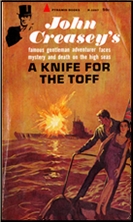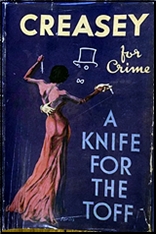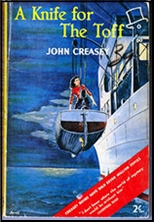Mon 26 Dec 2022
A Mystery Review by David Vineyard: JOHN CREASEY – A Knife for the Toff.
Posted by Steve under Reviews[2] Comments
JOHN CREASEY – A Knife for the Toff. Richard Rollinson #24. Evans, UK, hardcover, 1951. Pyramid R-1097, paperback, 1st US edn, 1964.

Richard Rollinson, the Toff is on the dance floor with the beautiful Camilla aboard a yacht owned by the ruthless and grossly fat Rumplemeyer who watches malevolently over them, and despite the seeming atmosphere of gaiety time is running out for the Toff as he flirts with his beautiful dancing partner.
“Yes…The facade of beauty and the interior decoration of corruption. What turned you from a sweet innocent child into a worshiper before the shrine of that maggoty Buddha? Was it just that gold glitters? Were your tiny feet turned off the straight and narrow path by the lure of the luscious life, or did some great tragedy blight your whole existence?â€
That, of course, is the authentic voice of the gentleman adventurer of the Twenties and Thirties however hardened and changed by the War. But the day of the swashbuckling poetry-spouting hero serenading bobbies in the street and speeding down narrow foggy roads in low slung cars is over. Tough guy Americans, Peter Cheyney, and the War ended all that and James Bond is about to put the boot in it for higher stakes than boodle.
It is 1951, and the breed has changed a bit, grown a shade tougher, and less concerned with the niceties. We are still two years out from James Bond, but at times it is hard not to wonder that the same things that influenced Ian Fleming’s licensed public executioner might not be haunting the Toff as well. He’s not quite the same man he was before the War.
The Toff was always the odd man out of the gentleman adventurer school. Not only was he genuinely from money and birth (“A gold spoon,†he tells Camilla when she accuses him of having been born with a silver spoon in his mouth). Despite that his knight errantry came with a social conscience, it is hard to imagine Simon Templar or Norman Conquest possessing, and however close he skirts it, he is never a desperado or outlaw, just a bit careless with the workings of the law when they interfere with justice.

Even in those rare cases where the villain he’s pursuing is a personal one (The Toff Goes to Market, in which Aunt Gloria is poisoned by wartime black marketeers), he’s far less likely to fling himself through plate glass windows with guns blazing or dangle the odd bad guy out windows than the Saint or 1066, and unlike Creasey’s other gentleman hero, the Baron, he would never take revenge on a social order that betrayed him.
It’s hard to imagine the Saint financing a club for boys in the East End like the Toff.
All that is about to go out the window with this one though. It is 1951, a new decade, and Rollinson is up against a different kind of bad guy than the usual petty master criminals he’s used to, and the fantastic Rumplemeyer has Rolly trapped on his yacht, the Lucretia, with only minutes to choose between a watery grave and serving a hideous criminal master.
While Creasey always opens well, it is unusual for him to put the Toff in the thick of it on page one and start ratcheting from that point on.
What Creasey excels at is the choreography of tension and action. His heroes are not the kind to stand around wondering what course to take. That’s another Bondian tie. They aren’t afraid to kick the card table over when they get a bad hand.
The Toff does escape, with the help of Camilla, who has fallen for him and reformed based on nothing but a kiss (shades of Pussy Galore, and there is more than one parallel here between Fleming and Creasey with a few bits similar to scenes in Diamonds Are Forever and Goldfinger), with both of them escaping on a lifeboat only to end up stranded at sea for ten days while they fall in love.

Meanwhile back at the farm the Toff’s man Jolly (like Tonto the brains of the outfit despite his comic relief role), his wealthy disapproving titled Aunt Gloria, East End boxer and pub owner Bill Ebbutt, and Rolly’s rival/friend Grice of the Yard believe him dead, which if nothing else gives us a chance to take a tour of the Toff’s trophy wall (the finest such museum outside the Yard’s Black Museum) replete with a top hat with a bullet hole in it, various knives, poisons, coshes, and a hangman’s rope that was used on one of the more unlucky types the Toff battled
Rollinson and Camilla are rescued, but when the get back to London, before they can even get off the ship, an attempt is made on their lives and Camilla receives a serious head wound thanks to Rumplemeyer’s man in the UK, the Wizard, who the Toff believes is one Colonel Merlin.
In almost every book the Toff finds himself at odds with the police, even hunted and forced to work alone, or with his unlikely allies in the East End, to defeat the threat at hand, but here it is with a vengeance. Always before the Toff was a justice figure, but the least bloodthirsty of the type.
Not here. He’s not defending the idea of justice, this time it is personal and he’s ruthless.
Granted he doesn’t go around popping off the unwashed with the vigor of the Saint or Norman Conquest, but he leaves a few bodies behind before he uncovers Rumplemeyer’s plot to use an illegally acquired submarine to hold up a shipment of gold bullion at sea (shades of Goldfinger and Assault on a Queen), ending with the Toff aboard a Royal Naval destroyer hunting down Rumplemeyer for a savage finish.
But that isn’t the end, the end is a bittersweet note with a bit of class conscious reality thrown in the mix, and here is where Creasey and Fleming really part ways, because by the last line the old irrepressible Toff is back, a bit heart sore and sadder but wiser. No year long benders getting out of shape and agonizing over his life choices for the Toff.
It’s not that he’s made of sterner stuff. Only that he is cut from thinner cardboard, and Fleming’s war was much dirtier than Creasey’s.
This is my favorite among the Toff novels, actually the second one I read at the easily influenced age of fifteen (the first was The Toff in New York), and part of what sold me was a great Jack Thurston cover with a top-hatted Toff in the upper left corner, cigarette holder in hand, while on the cover the Toff and Camilla stand on the deck of something (hard to say what) as fireworks go off on the deck of a surfaced submarine behind them.
I’m fairly sure that cover would have sold me any book, whether I had ever heard of Creasey or not (and no, that scene isn’t in the book).
I reread the book for this review with only a shade less enjoyment than when I first read it. While it has many of Creasey’s problems as a writer it also has all of his virtues, which for me outnumber the former, and today has the added cachet of how much it has in common with some of the Bond’s to come and the changing tone of the Post-War British thriller.
No, I don’t think Fleming read Creasey, though it is possible, but I do think both men were reflecting something new to popular fiction in that time period that came out of the War each in their own way, and to be perfectly fair, the Toff being on that destroyer doesn’t make any more sense than Bond manning a Bofors gun in South Africa at the end of Diamonds are Forever, but I’m grateful to Creasey and Fleming for not caring and doing it anyway. (*)
(*) And I was grateful when Philip McCutchan’s Commander Esmonde Shaw and James Dark’s Mark Hood finished with similar scenes in their adventures. I like my fictional t’s crossed and i’s dotted, whether it makes sense or not.
December 26th, 2022 at 8:31 pm
Glad I could find the cover of the very same Pyramid paperback you first read way back then, David.
I don’t remember reading this one, but I bought it and several others that seemed to be coming out all at the same time from several publishers, all in paperback: Pyramid, Lancer, and Popular Library. And all the first American editions.
Strangely enough, Creasey had the hardest time cracking the hardcover market in the US for the longest time.
December 27th, 2022 at 10:57 pm
He broke into the American hardcover market in the Thirties with the Baron, Blue Mask over here for some reason, but only two were published that I know of probably because of the War, then he doesn’t really show up again until the Mark Kilby series and a one-off DANGER WOMAN as Abel Mann for Pocket Books while he was living in Arizona (near Georges Simenon — pity the poor postman delivering author’s copies and galleys to those two).
The Toff Pyramid series and Signet Gideon (rave reviews of the latter series didn’t hurt, the Signet books all had cover blurbs by John D. MacDonald) were his biggest breakthroughs. Berkeley did the Roger West books which evidently sold very well, and eventually some of the Dr. Palfrey books trying to sell them as Doc Savage style adventures, I think some others ended up at Lancer. Popular Library eventually had Patrick Dawlish and Gordon Craigie, Avon the Baron, and then West at Lancer after his Berkeley run.
The Dr. Cellini books were published in hardcover as by Michael Halliday, but not the Richard and Martin Fane series.
Creasey got two big breaks in the late Fifties and early Sixties when John Ford directed GIDEON OF SCOTLAND YARD and THRILLER adapted the Gordon Ashe Patrick Dawlish thriller THE CRIME HATERS as an episode and pilot for a series that never developed. Aside from the earlier two Toff movies there was also a non series Michael Halliday film with Lee Patterson.
By the time the Steve Forest THE BARON series from ITV hit American screens Creasey was already well situated.
I don’t know if anyone but Walker did the hardcovers. Creasey, like several British writers of his genre out of the Edgar Wallace tradition, had difficulty breaking the American market because of stylistic differences in storytelling tropes but after he lived in Arizona for a while he pretty much cracked the market wide open.
Even the Bruce Murdoch Liberator series eventually saw publication here from Walker (updated and rewritten by Creasey and including THE WITHERED MAN and I AM THE WITHERED MAN).
His Westerns and Romance novels and his Sexton Blake titles were never reprinted here, but other than a few Michael Halliday one shots and the Richard and Martin Fane private detective novels I think most of his detective novel series were at least represented here.
By the Seventies Creasey had cracked the slicks (REDBOOK) with his Roger West series and serialization in newspapers that still serialized novels and was getting strong praise for his West sub series with city titles like MURDER LONDON-NEW YORK that got West out of the country.
His MASTERS OF BOW STREET was a NYTIMES bestseller.
I wish I recalled where I read it, but I do recall reading a good discussion on the reason the Creasey, Berkely Gray, Roderic and Bruce Graeme, Peter Cheyney, David Hume, Francis Durbridge, Ernest Dudley, Gerard Fairlie, Victor Gunn, and T. C. H. Jacobs had trouble breaking into the American market and it had to do with the expectations of American readers and British (and Canadian and Australian ones) about character and story development and the struggle those writers had adjusting to the American style where the protagonist was expected to develop more over the course of the book than in British thrillers.